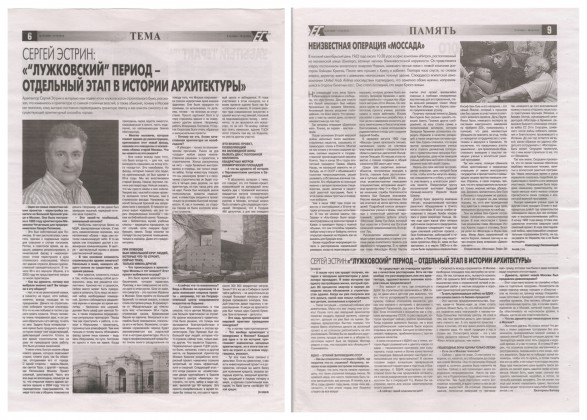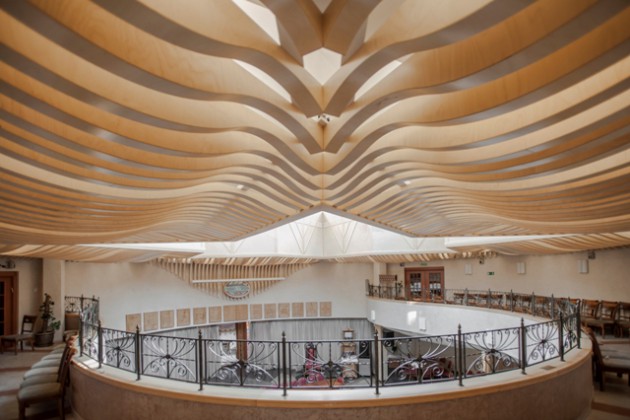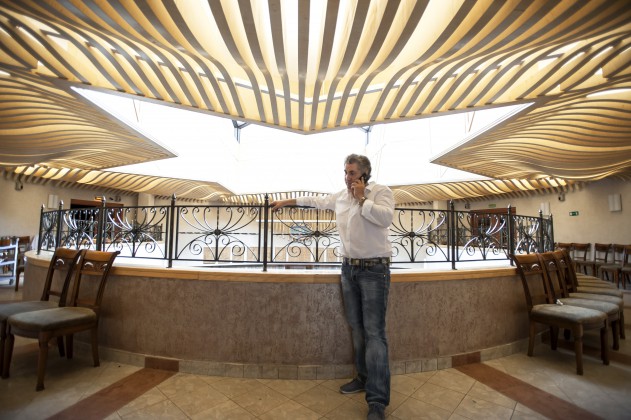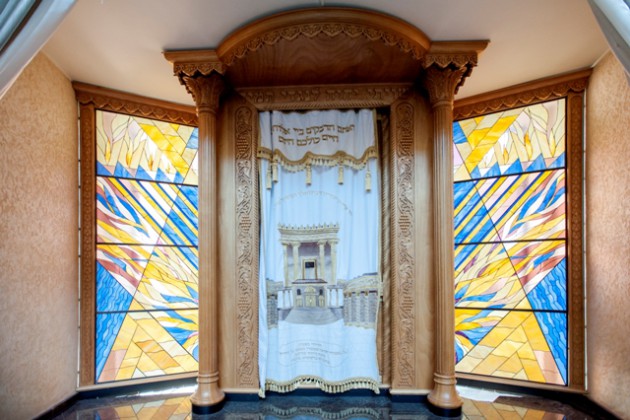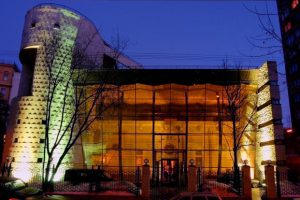Ekaterina Wagner. Sergey Estrin:”Luzhkov period – era in architecture history” | jewish.ru, 25.09.2015
Architect Sergey Estrin, author of Bolshaya Bronnaya Synagogue reconstruction, has told jewish.ru about his project as well as about current and past problem spots in Moscow architecture.
– One of your most famous projects – reconstruction of synagogue on B. Bronnaya. Tell us how it started
It used to be a home synagogue of Poliakov, in Soviet days in was closed, the rabbi has become a subject to repression, old facade was rebuilt. For many years the building has served for amateur activities. At the beginning of nineties it was returned to community. In 2002 the representatives of Synagogue have started negotiations with me.
– Why do you think they have chosen you? Were you a member of community?
No, I am not from religious family I was not used to synagogue visits, although now I visit on holidays. The money for construction was raised by private sponsors. One of them has visited my client, liked the house and decided to apply to me. The objective was interesting, I had to create a history around existing, working synagogue. By the way, during the period of construction the synagogue was not closed even for a day. I have very soon developed the main image of the new synagogue, the image of new building holding and covering the old one like a hand. From one side – the tower palm, like Torah scroll, from the other – fingers, like Humash. The project was complicated. Some of the interior works were postponed due to the lack of funds. Thus the Gala Hall ceiling was only completed recently.
-Tell us about this ceiling.
Unusual curved beams of MDF are veneered with maple. They have symbolic meaning they remind of clouds as the ceiling itself represent the sky. At the same time the shape makes the access to utilities more manageable. In the middle there is a window in the shape of hexagram. The ceiling with all its intricacy did not cost much. As it should be in a synagogue. Everything is built on community money.
– What is difficult about building a synagogue? I believe there is no canon.
The most difficult part was to make everyone agree, as everything was decided collectively. There are no rules and basically any building could be made into synagogue. There is a list of required premises. There should be a closet for Torah, certain ritual proportions should be maintained, men should pray separately from women. Prior to designing the synagogue I went to Jerusalem, to see, to feel the character. There I had an idea to face the facade with one stone – the entire Jerusalem is build from the same stone. Stepping through the gates of the synagogue one find oneself it a place distantly, yet resembling the Promised Land.
– Many people, who remember the building before reconstruction criticised the new facade, saying that it ruins the look of old Moscow.
Everything new would be worse for those lived their young life back then. It’s inevitable. The facade these people remember is not the original one. It was built in fifties. We have restored the old one. We found the drawings, have hired the restorer. I assure you there more thoughts put into new project then into Stalin facade. For example the large window with menorah is facing the curve of Bronnaya street. When lit it is well seen from far away. Curved columns by glassed facade is a hint on Noah’s Ark. The premises of the library, museum, class rooms are protected by corridor in case someone decides to cast a stone.
-What was going in Moscow architecture at the time? Did the project stand apart from the rest?
It was the time of “tower architecture” that Luzhkov liked so much and we did not want to go along at all. We started from the idea that it is a piece of Israel in Moscow. If you’d walk along Bronnaya street you would fail to determine the style it was built to. There you have everything – glassed buildings from the sixties, Stalin school, Brezhnev brick tower. It was difficult to fir into ensemble as it didn’t exist. Maybe one day the Luzhkov period will be considered as some stage of architecture history development. But at the tame professional environment has demonstrated a lot of annoyance with the fact that Moscow was built by cheap buildings, even at a first glance.
-Why the quality architecture did not dominate?
I am certain for economic reasons only. The market accepted any poor quality solutions both in design and construction. Apartments were bought before completion. The market was young, the risks were high, money were expensive and investors were interested in quick payback. I also understand there wasn’t much control from the city.
– What has changed today? Moscow still comes up with questionable project. State Centre of Modern Art on Khodynka, for example.
The situation has changed in a way as not much is being built today in the centre. The city government has decided to improve the landscape and the roads. In Luzhkov times there was a small circle of people that built something, today it’s the circle still exist but with different names. As for Khodynka… Initially the building was planned to be on Baumanskaya. Architect Michael Khazanov has developed an interesting project. Most probably a very costly one, yet rather spectacular. Then it was decided to build the museum at the back yard of the Europe largest shopping mall Aviapark, basically as a 80 meters high fence. It’s simply offensive: the only people getting to museum would be those lost on the way to shopping. I also took part in this competition, but in my design the building was sank to the ground. As if I buried modern art and made a lug above the ground looking like raising head. Made it unclear whether the art will wake up or not. As far as I know, things have changed and the construction plot was moved again.
-What do you think about Parliament Centre story on Zariadie?
I absolutely agree with those saying that it is a business project that allows to squeeze out of protected area two and a half million square meters of commercial space. It is the only piece of Moscow that could be inherited by generation to come. There are about 450 people in Duma and for them 30,000 sqm were spared. The way the competition was held is also questionable. Each participant was signing non-disclosure agreement. In jury there was only one architect – Sergey Kouznetsov, the rest were deputies.
-Does it contradict the world practice?
As well as any logic.
– What in general is going on with open biddings in Moscow? Same thing happens all the time, they invite famous western architects, the project does not get to be built and the architect is leaving having fight with everyone.
It all has to do with money. If you are a developer with investment project and in your collateral brochure you state western lawyers, world top five architect and large construction company, it will be easier for you to get your loan approved. With money received the interest towards expensive architect is less significant.
– What do you think about VDNKh situation? Where they built oceanarium against all rules.
I am glad something is happening and this enormous area is getting some life. It is not abandoned anymore. I took my son their back in nineties and was ashamed to see the state of the place.
– There is also a problem with quality of restoration. Do you think it worth an afford or is it an architecture with exaggerated artistic significance?
It very much depends ones perception of VDNKh. The construction was completed in 1954. Even when I was a child I thought of it as something out of date and pointless. Nowadays we think of it as history, as of films with Ladynina where everyone wears white.
– Is there a Master Plan of Moscow?
Now, I don’t even know. It used to be topic of conversations a lot. But I believe it was before New Moscow came about. It is bigger than the old one and should have its influence. No one expected high raise construction in Moscow suburbs. There are many cottage villages with sudden 22-storey neighbours.
– What do you think of pedestrian zones of Moscow?
They are most fortunate. But only in summer. How good are these wide sidewalks without any possible parking during wet autumn and filthy winter. In Europe the situation is different, in winter +5 and decent drainage systems. We have -15 and slush! I am certain that many little shops and restaurants will have to close. People can’t walk miles to buy something and then to carry it back. There are places where it’s even hard to call for a cab, it wouldn’t be able to stop and wait.
Ekaterina Wagner for jewish.ru

